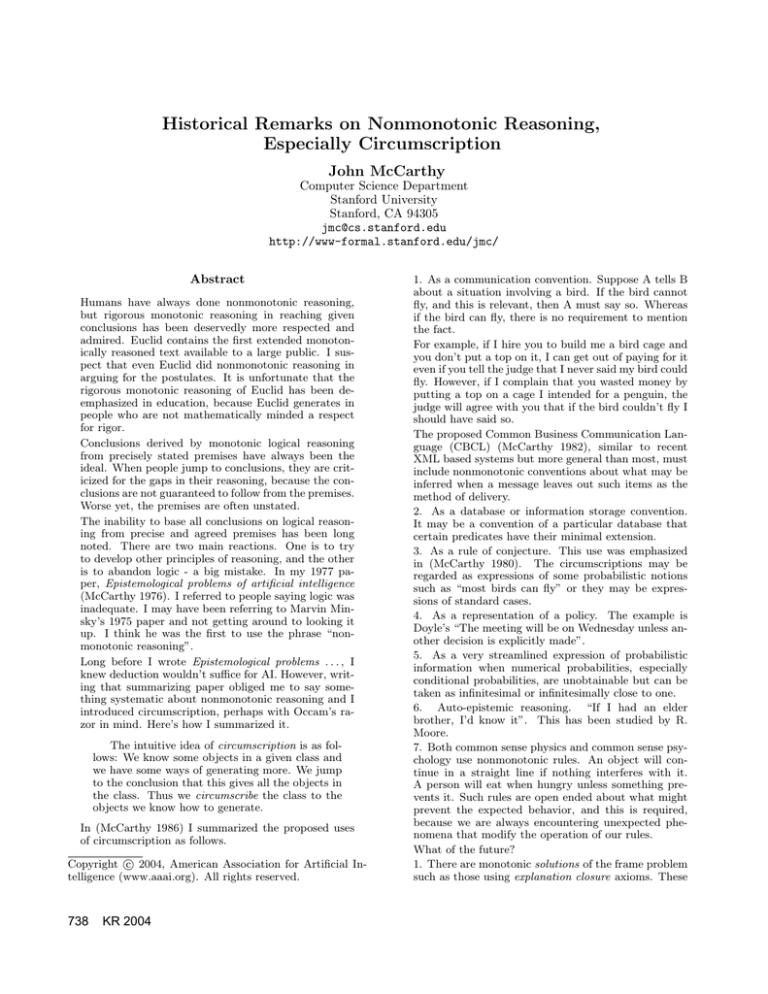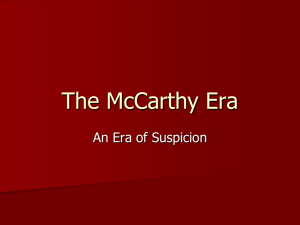
Historical Remarks on Nonmonotonic Reasoning,
Especially Circumscription
John McCarthy
Computer Science Department
Stanford University
Stanford, CA 94305
jmc@cs.stanford.edu
http://www-formal.stanford.edu/jmc/
Abstract
Humans have always done nonmonotonic reasoning,
but rigorous monotonic reasoning in reaching given
conclusions has been deservedly more respected and
admired. Euclid contains the first extended monotonically reasoned text available to a large public. I suspect that even Euclid did nonmonotonic reasoning in
arguing for the postulates. It is unfortunate that the
rigorous monotonic reasoning of Euclid has been deemphasized in education, because Euclid generates in
people who are not mathematically minded a respect
for rigor.
Conclusions derived by monotonic logical reasoning
from precisely stated premises have always been the
ideal. When people jump to conclusions, they are criticized for the gaps in their reasoning, because the conclusions are not guaranteed to follow from the premises.
Worse yet, the premises are often unstated.
The inability to base all conclusions on logical reasoning from precise and agreed premises has been long
noted. There are two main reactions. One is to try
to develop other principles of reasoning, and the other
is to abandon logic - a big mistake. In my 1977 paper, Epistemological problems of artificial intelligence
(McCarthy 1976). I referred to people saying logic was
inadequate. I may have been referring to Marvin Minsky’s 1975 paper and not getting around to looking it
up. I think he was the first to use the phrase “nonmonotonic reasoning”.
Long before I wrote Epistemological problems . . . , I
knew deduction wouldn’t suffice for AI. However, writing that summarizing paper obliged me to say something systematic about nonmonotonic reasoning and I
introduced circumscription, perhaps with Occam’s razor in mind. Here’s how I summarized it.
The intuitive idea of circumscription is as follows: We know some objects in a given class and
we have some ways of generating more. We jump
to the conclusion that this gives all the objects in
the class. Thus we circumscribe the class to the
objects we know how to generate.
In (McCarthy 1986) I summarized the proposed uses
of circumscription as follows.
c 2004, American Association for Artificial InCopyright telligence (www.aaai.org). All rights reserved.
738
KR 2004
1. As a communication convention. Suppose A tells B
about a situation involving a bird. If the bird cannot
fly, and this is relevant, then A must say so. Whereas
if the bird can fly, there is no requirement to mention
the fact.
For example, if I hire you to build me a bird cage and
you don’t put a top on it, I can get out of paying for it
even if you tell the judge that I never said my bird could
fly. However, if I complain that you wasted money by
putting a top on a cage I intended for a penguin, the
judge will agree with you that if the bird couldn’t fly I
should have said so.
The proposed Common Business Communication Language (CBCL) (McCarthy 1982), similar to recent
XML based systems but more general than most, must
include nonmonotonic conventions about what may be
inferred when a message leaves out such items as the
method of delivery.
2. As a database or information storage convention.
It may be a convention of a particular database that
certain predicates have their minimal extension.
3. As a rule of conjecture. This use was emphasized
in (McCarthy 1980). The circumscriptions may be
regarded as expressions of some probabilistic notions
such as “most birds can fly” or they may be expressions of standard cases.
4. As a representation of a policy. The example is
Doyle’s “The meeting will be on Wednesday unless another decision is explicitly made”.
5. As a very streamlined expression of probabilistic
information when numerical probabilities, especially
conditional probabilities, are unobtainable but can be
taken as infinitesimal or infinitesimally close to one.
6. Auto-epistemic reasoning. “If I had an elder
brother, I’d know it”. This has been studied by R.
Moore.
7. Both common sense physics and common sense psychology use nonmonotonic rules. An object will continue in a straight line if nothing interferes with it.
A person will eat when hungry unless something prevents it. Such rules are open ended about what might
prevent the expected behavior, and this is required,
because we are always encountering unexpected phenomena that modify the operation of our rules.
What of the future?
1. There are monotonic solutions of the frame problem
such as those using explanation closure axioms. These
encode all admitted causes of change. The nonmonotonic reasoning is done by the human who wrote the
axioms. Explanation closure is not elaboration tolerant; introducing new actions or new conditions for the
success of actions requires surgery on the explanation
closure axioms. This is ok as long as the scientific or
practical objectives are sufficiently limited. Humanlevel AI or even reasonable elaboration tolerance will
require the computer to do nonmonotonic reasoning.
2. In my opinion many variants of nonmonotonic reasoning that have been introduced, e.g. Vladimir Lifschitz’s pointwise circumscription, have been insufficiently studied.
3. (McCarthy 1986) introduces simple abnormality theories in which a single predicate ab is minimized while
all other predicates are varied. Lifchitz and McDermott
respectively showed that particular simple abnormality theories for the blocks world and the Yale shooting
problem suffered from unintended models. It remains
possible that a simple abnormality theories with different predicate symbols and axioms could handle these
problems. I conjecture that this won’t work; certain so
far unstated limitations apply to all simple abnormality
theories.
4. I think minimization of predicates, i.e. circumscription, is here to stay, but this doesn’t cover all possible
future developments in nonmonotonic reasoning.
5. (McCarthy 1980) mentions such entities as “things
wrong with the boat” and suggests minimizing them.
No formulas are given, but I think such abstract entities will be needed even for a proper treatment of the
missionaries and cannibals problem.
References
McCarthy, J. 1976. Epistemological Problems in Artificial Intelligence1 . reprinted in (McCarthy 1990).
McCarthy, J. 1980. Circumscription—A Form of NonMonotonic Reasoning2 . Artificial Intelligence 13:27–
39. Reprinted in (McCarthy 1990).
McCarthy, J. 1982. Common Business Communication Language3 . In A. Endres and J. Reetz (Eds.),
Textverarbeitung und Bürosysteme. R. Oldenbourg
Verlag, Munich and Vienna.
McCarthy, J. 1986. Applications of Circumscription
to Formalizing Common Sense Knowledge4 . Artificial
Intelligence 28:89–116. Reprinted in (McCarthy 1990).
McCarthy, J. 1990. Formalizing Common Sense: Papers by John McCarthy. Ablex Publishing Corporation.
1
http://www-formal.stanford.edu/jmc/epistemological.html
http://www-formal.stanford.edu/jmc/circumscription.html
3
http://www-formal.stanford.edu/jmc/cbcl.html
4
http://www-formal.stanford.edu/jmc/applications.html
2
KR 2004
739




